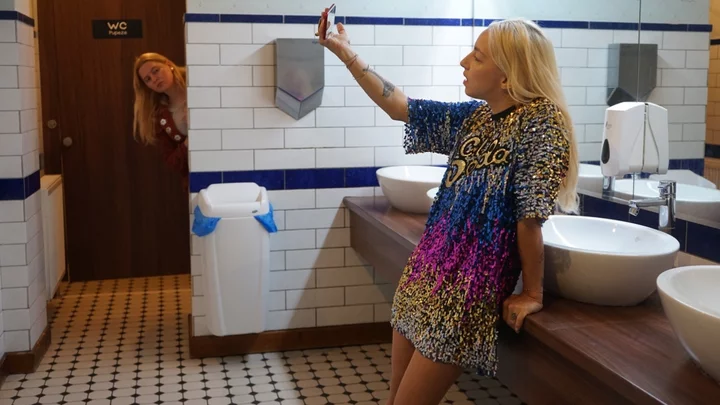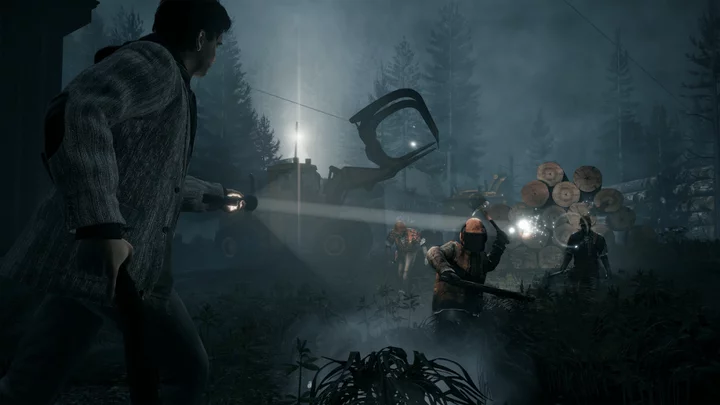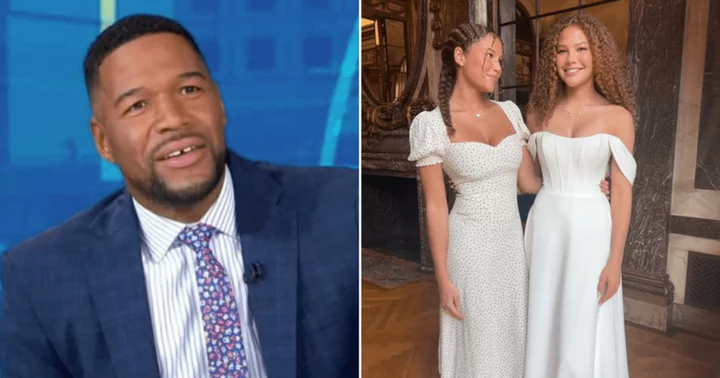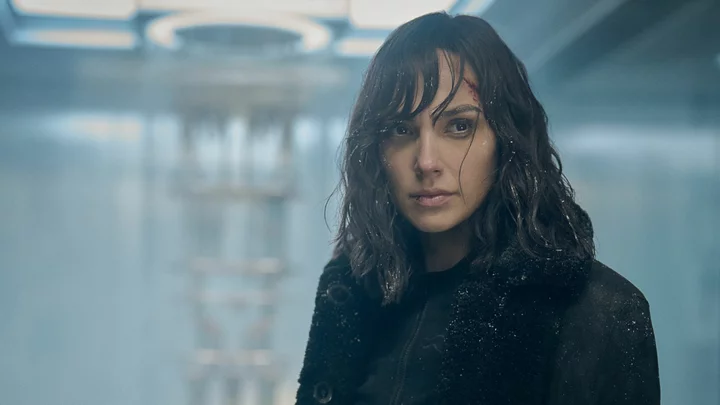At two hours and 43 minutes, Do Not Expect Too Much From the End of the World (or Nu astepta prea mult de la sfârsitul lumii) is far longer than your average comedy. It's also far more absurd in a way that demands this humongous runtime, coming preloaded with enough ideas for an entire series of satirical films. Its story follows burnt-out millennial production assistant Angela (Ilinca Manolache) across a single day. Through this tale of the modern gig economy, Romanian director Radu Jude explores the entanglement of contemporary image-making with the internet, cinema's past, and corporate capitalism.
SEE ALSO: 11 films you'll want to see out of NYFF 2023Angela's errands, auditions, and memorable encounters during her exhausting shift make up the movie's overarching structure. However, Jude packs his film to the gills with wild aesthetic detours that — though they seem to depart from Angela's narrative — end up cleverly complimenting it. At times, it feels like three or four different movies packed into one, between its central comedy, an extended montage of headstones, and inserted footage of a Romanian feminist drama from the 1980s — a sister film of sorts, which Do Not Expect Too Much mirrors in surprising ways.
Together, the result of these various ideas and approaches being carefully smashed together is as riotous as it is thoughtful and self-reflexive, harkening back to the French New Wave while keeping one eye on the future of evolving media.
What is Do Not Expect Too Much From the End of the World about?
Credit: Courtesy of HereticAn immediate stylistic contrast emerges in the movie's opening scenes, when — as if to create a temporal paradox through visual texture — a clear close-up of a smartphone screen is filmed in grainy black-and-white. New and old, hi-tech and lo-fi, collide as Angela's iPhone alarm begins blaring (with that familiar, grating jingle that unsettles when heard out in the wild). Without the time for a shower, she throws on her bra and shiny sequin dress and rushes out the door, laptop and camera equipment in hand.
Manolache wears Angela's weary irascibility on her sleeve. However, she knows exactly how to modulate it, depending on who she's around and what space she finds herself in, from snapping at the casual, anti-Romani racism of passersby — she has a strong sense of social justice — to stealthily navigating similar sentiments from her workplace superiors, i.e. when she literally can't afford a confrontation. She drives around Bucharest's crowded roads, stopping only for occasional fast food bites and roadside naps, as she travels between the homes of various audition subjects for a video she's helping shoot for a German multinational corp. These subjects are grievously injured or disabled, thanks to workplace accidents at the company's various factories and warehouses. It's Angela's job to record and sift through the victims whose stories might make for the most friendly and least legally troublesome training videos, as they warn their fellow workers to follow company guidelines lest they end up in wheelchairs too.
The irony of Angela's job is all too clear: She's an overworked, underpaid PA making internal "content" for a company hoping to put on a worker-friendly face.
A character comedy first and foremost, Do Not Expect Too Much From the End of the World beats with a righteous fury of the state of things.Between each audition, with subjects ranging from highly idiosyncratic to deeply heart-rending, Angela makes content of her own, using her phone's front camera and a caricatured filter that gives her a bald head, a unibrow, and an obnoxious goatee, which the movie presents in color and a vertical aspect ratio. This smug alternate persona she creates — a rich playboy named Bobita, who speaks in racist, sexist, anti-"woke" buzzwords; think Brian Jordan Alvarez by way of Andrew Tate — has been gaining traction on TikTok; another collision of past and future, through technological progress, and the backward moral regress it often grants permission. The more Angela funnels her daily frustrations into this bitter, vulgar satire (shot in plain view of various onlookers), the more ostentatiously funny her vignettes become, both because of what she says and because of the real circumstances in which she says them.
At the same time, these aforementioned stories are frequently interrupted with color scenes from a 1981 Romanian movie by Lucian Bratu, Angela merge mai departe (or Angela Moves On), in which actress Dorina Lazar also plays a character named Angela. The twinning of these namesakes extends to both movies' vibes, which explore the frustrations experienced by Romanian women, especially on the road. The younger Angela, of Jude's film, makes her money by driving between far-flung destinations, and she even mentions how, on her days off from PA work, she spends her time picking up Uber rideshares. The older Angela, of the 1981 film, is a divorced taxi driver at a time when women didn't often work such jobs. The footage Jude employs shows her dealing with various unruly male customers.
These three stories, of Bobita and the two Angelas, unfold side by side with what initially seems like little overlap. But they soon become entangled in intriguing ways, both through Jude's tongue-in-cheek commentary on the meta-textual nature of modern media, as well as through his stylistic exploration (and manipulation) of the images he presents.
Do Not Expect Too Much From the End of the World is a self-reflexive media satire.
You could draw a straight line between the French New Wave and Radu Jude, a mainstay of the more recent Romanian New Wave. Never has this been more clear than in Do Not Expect Too Much, which all but quotes Jean-Luc Godard's Breathless in certain shots. Godard's early work set the stage for what modern film language would become, between his self-reflexive focus on Hollywood's influence on French cinema culture, to his then-novel use of jump cuts and lengthy takes. Though what Godard could not have foreseen is the way new media, like YouTube, TikTok, and the now-defunct Vine, would inadvertently adopt his conventions too, from the discontinuous and jarring nature of video shitposts, to jump cuts becoming a common fixture of lengthy vlogs.
However, where the jump cuts in Breathless — most noticeable when Godard shoots Michel (Jean-Paul Belmondo) and Patricia (Jean Seberg) driving from behind — broke the conventions of continuity by skipping through time, the modern jump cut in most vlogs serves the opposite function. It often ensures a sense of continuity by cutting out pauses and pasting together fragments of different takes (or the same take), building complete sentences and ideas in defiance of traditional notions of cinematic time, space, and, unfortunately, rhythm.
Jude draws from both these approaches in scenes where Angela drives. At one point, when she picks up her mother for a quick chat between two of her pit stops, Jude recreates the rear angle and breezy feeling of Michel and Patricia cruising through Paris streets. He even employs jump cuts at a similar moment to Godard, only he does so in the middle of sentences, which begin on one side of the cut and end on the other, breaking one kind of continuity — the visual — while creating an aural and intellectual continuity where none would ordinarily exist. It looks wrong but feels right, as though he were reintroducing the sense of rhythm to this technique that's been lost over the years.
New media hallmarks appear throughout Do Not Expect Too Much, whether on Angela's lengthy, lonely drives, which Jude shoots as though they were intimate car vlogs — an increasingly common backdrop for amateur online content — or via the face-morphing filter she applies to create Bobita, which she forgets to turn off sometimes, leading to some rip-roaring moments. Even the film's aforementioned extended montage, depicting hundreds of gravestones lining a dangerous road, not only denotes the possibility that Angela might also become the victim of a road accident — given her exhaustion — but also seems to emanate from her imagination as a filmmaker in the digital age.
The idea stems from casual small talk that she exchanges with her domineering German boss (Nina Hoss). And while the form it takes has the appearance of traditional cinema — from its aspect ratio, to its careful composition, to the vibrant colors that interrupt Angela's black-and-white chatter — the way it's edited has an uncanny, almost rhythmic familiarity. Each still shot lasts just long enough for you to absorb the information before another replaces it, as though you were scrolling through these images on Instagram.
The effect of these flourishes ranges from hilarious to introspective, culminating in a forty-something-minute unbroken take that crystallizes the film's themes of labor rights, looming racial animus, and the distressing influence of corporate money in nearly every sector of artistic expression. Jude even makes deviously funny use of the cue card concept in Bob Dylan's music video for "Subterranean Homesick Blues,' resulting in a striking satirical streak that grows increasingly surreal.
However, its most overt flourishes and statements tend to surround its use of Bratu's Angela merge mai departe, which are both its occasional undoing (Jude's aesthetic manipulations here don't feel quite as exacting) as well as its most bizarre triumph, as Do Not Expect Too Much becomes so self-reflexive in nature that it circles back around and becomes its own sequel.
Do Not Expect Too Much From the End of the World is a secret sequel — kind of?!
The footage of Angela merge mai departe used in this film is the first that most non-Romanian viewers will have seen of Bratu's work. There's probably a good half hour of it spliced throughout Jude's narrative, and given the 1981 movie's mere 76-minute runtime, that's a significant chunk. That Do Not Expect Too Much contains this much of Angela merge mai departe automatically raises the question of what exactly makes up Do Not Expect Too Much, and how much of its authorship can really be attributed to Jude alone.
Is the fact that Jude manipulates some of Bratu's scenes enough? On occasion, he slows the footage down significantly, but for the most part, he presents much of the story wholesale for the purpose of thematic cross-pollination. The two Angelas are bound by common circumstances but separated by time; it's as though Do Not Expect Too Much were some niche modern reboot. However, this idea comes full circle with bizarre audacity when Lazar herself (the actress who plays Angela in the 1981 film) shows up in Jude's film, turning Do Not Expect Too Much into a pseudo-sequel of sorts — to Angela merge mai departe. But given the matryoshka doll nature of Do Not Expect Too Much, it also becomes a sequel to itself in a way, as though it were the product of some mad scientist media experiment.
The nature of contemporary "legacy sequels" also enters Jude's crosshairs, making even more explicit his scrutiny of modern media's relationship to the cinematic past. Where Godard's examination in Breathless was about French cinema's relationship to American cinema as an idea — the broad strokes of popular genres, and iconic figures like Humphrey Bogart, whom Michel impersonates — Jude probes the idea of modern image-making as less of a refraction of the past and more as a sanitized reflection of it.
He also does this amidst a bleakly funny exposé of the moral considerations of the modern image as well, from who truly gets to determine the form and meaning of images, to what a radical approach to filmmaking and critique might actually look like in the age of unfettered access to all perspectives at once. (His potential answer, via the tongue-in-cheek on-screen appearance of a notorious filmmaker, rides the lines between irony and sincerity.)
A character comedy first and foremost, Do Not Expect Too Much From the End of the World beats with a righteous fury of the state of things. However, its short-tempered protagonist has nowhere to channel that same fury but into something cheap and crass, albeit something that contains more honesty and is made more ethically than the polished and expensive productions to which she's beholden. What moving images mean is something constantly in flux, and in the information age, each image itself is vulnerable to digital manipulation, creating a fundamental mistrust between movies and the human eye. That this is our new, apocalyptic reality bears a strange sense of tragedy. But if that tragedy is tweaked in just the right way, by the likes of Radu Jude, it becomes darkly funny too.
Do Not Expect Too Much From the End of the World was reviewed out of the New York Film Festival.









